CDOT seeks input on improvements to US 34 intersections at 35th and 47th avenues in Greeley
News Release
GREELEY — The Colorado Department of Transportation wants to hear from you about your thoughts on several different ideas for how to improve the US 34 intersections at 35th and 47th avenues in Greeley.
Development along US 34 is increasing travel demand and requiring safety improvements, reducing congestion and improving mobility. The current intersections at 35th and 47th Avenues have numerous issues.
A video presentation on the alternatives, also outlined below, has been posted on the CDOT project website at https://www.codot.gov/
Funding and schedule for when these changes could possibly occur is not yet available, but these alternatives build on the goals, recommendations and analysis included in the US 34 PEL Study, published in January 2019. That study recommended conversion from intersections to interchanges at 35th and 47th Avenues. This project is exploring interchange alternatives considering the following goals:
Increase safety: increased development and travel demand are causing safety concerns. The recommended improvements will safely support growth and congestion.
Accommodate future demand: the recommended design improvements will accommodate the increased travel and tourism demands to maintain economic vitality in the City of Greeley and Northern Colorado.
Increase reliability: the recommended design improvements will increase the travel time reliability of east-west travel on US 34. In addition, it will support access and mobility needs for local communities and businesses while improving freight movements along the corridor.
Minimize impacts: identify interchange alternatives that minimize property and environmental impacts within the project area.
Three interchange design alternatives have been developed for the US 34 intersections with 35th and 47th Avenues. The proposed interchange alternatives have passed the initial review process, meeting the minimal requirements to proceed into the second phase of analysis. The initial criteria to review the interchange designs included safety, access, property impacts, multimodal connections, noise and congestion.
35th Avenue Intersection
At the 35th Avenue intersection, all design alternatives would have US 34 over 35th Avenue and would provide full access in both directions to US 34 from 35th Avenue. A key design feature for developing an interchange at this intersection is accommodating westbound US 34 traffic exiting to 35th Avenue and integrating traffic from 28th Street. In alternative 1 (Partial Diamond-Loop), left turns from 28th Street to 35th Avenue would no longer be allowed. The intersection of 35th Avenue and 28th Street would be controlled by a stop sign or traffic signal on 28th Street. A newly constructed traffic signal at the ramp intersection would control 35th Avenue through traffic and the US 34 westbound entrance and exit ramps. A second traffic signal would be installed south of the interchange to provide eastbound access to US 34 via a loop ramp and eastbound US 34 traffic to 35th Avenue.
Alternative 2 (Frontage Road Underpass-Loop) turns 28th Street into a right-in/right-out intersection at 35th. Left turn traffic accessing 28th Street from 35th would use a newly constructed road that would travel east and under the US 34 westbound exit ramp to 28th Street, while left turn traffic from 28th to 35th would utilize a connector to the westbound exit ramp.
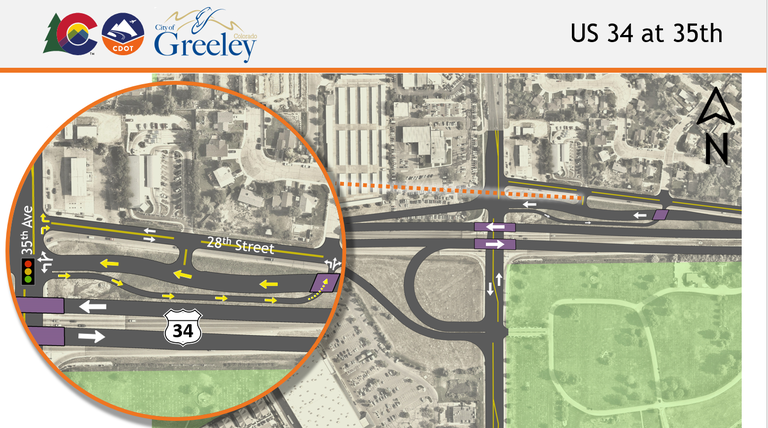
Lastly, in alternative 3 (Tight Urban Diamond), 28th Street traffic would be similar to Alternative 1, but traffic travelling from northbound 35th Avenue to westbound US 34 would take the same exit as US 34 eastbound traffic, but travel under US 34 to merge with westbound US 34 traffic exiting to 35th Avenue. Traffic would travel through a new signalized intersection to the newly constructed US 34 westbound entrance ramp.
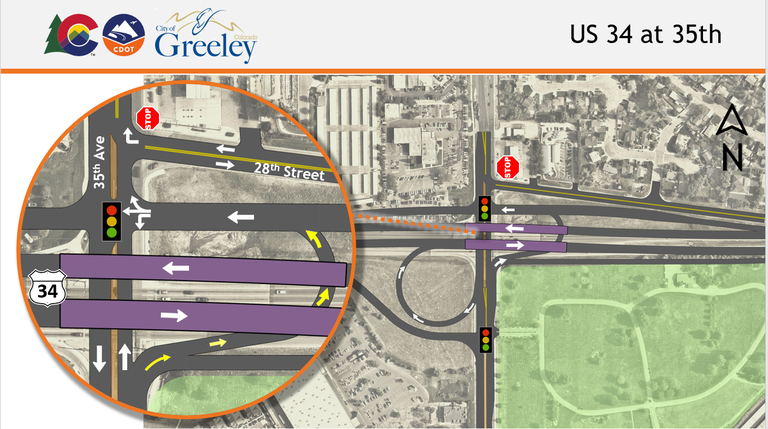
47th Avenue Intersection
At the 47th Avenue intersection, three different interchange configurations have been proposed: a standard diamond, a diverging diamond and a single-point urban interchange. US 34 would be over 47th Avenue in all the interchange alternatives. Alternative 1, the standard diamond interchange, provides full access to US 34 in both directions. New traffic signals would be installed at the exit and entrance ramps to enable left turns onto 47th Avenue and the ramps in both directions.
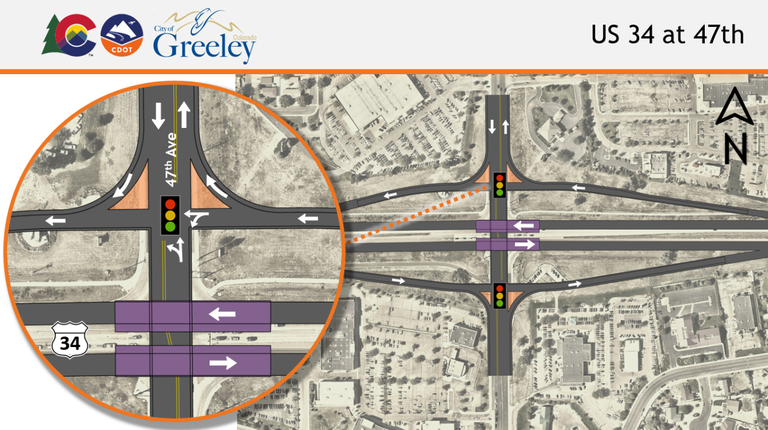
In alternative 2, a diverging diamond interchange, traffic travelling on 47th Avenue would cross over to the left side of the road to travel under US 34. Traffic signals on the north and south side of the interchange would enable the traffic to travel on the left side for this portion of the roadway. Shifting the traffic to the left side of the road enables unsignalized free-flow left turns to US 34.
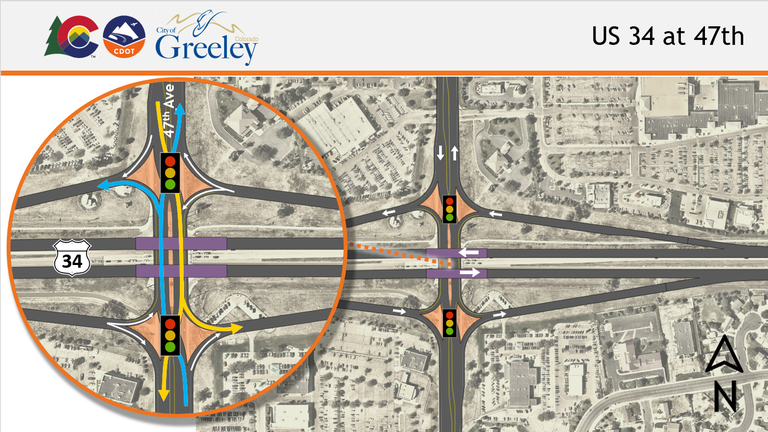
Alternative 3 is the single-point urban interchange, which controls all left turn exit and entrance movements for US 34 and the through movement on 47th Avenue with one traffic signal.
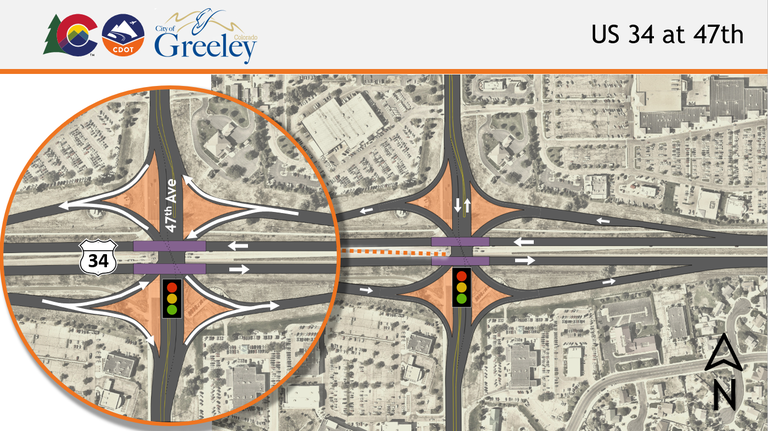
COVID-19
Safe transportation infrastructure is essential for emergency first responders and freight drivers as Colorado navigates the COVID-19 pandemic. With that in mind, road maintenance and construction continues on CDOT projects with social distancing and other health safety measures to reduce COVID-19 exposure on the worksite. The Colorado Department of Public Health and Environment announced guidelines for construction activities. The public is urged to join the campaign for #DoingMyPartCO by practicing social distancing, wearing face masks, staying at home when possible, and avoiding nonessential travel. With fewer vehicles on the roads, CDOT crews will be able to work more efficiently and safely.
REMEMBER: SLOW FOR THE CONE ZONE
The following tips are to help you stay safe while traveling through maintenance and construction work zones.
-
Do not speed in work zones. Obey the posted speed limits.
-
Stay Alert! Expect the unexpected.
-
Watch for workers. Drive with caution.
-
Don't change lanes unnecessarily.
-
Avoid using mobile devices such as phones while driving in work zones.
-
Turn on headlights so that workers and other drivers can see you.
-
Be especially alert at night while driving in work zones.
-
Expect delays, especially during peak travel times.
-
Allow ample space between you and the car in front of you.
-
Anticipate lane shifts and merge when directed to do so.
-
Be patient!
WHOLE SYSTEM. WHOLE SAFETY.
To heighten safety awareness, CDOT recently announced its Whole System — Whole Safety initiative. This project takes a systematic statewide approach to safety combining the benefits of CDOT’s programs that address driving behaviors, our built environment and the organization's operations. The goal is to improve the safety of Colorado’s transportation network by reducing the rate and severity of crashes and improving the safety of all transportation modes. The program has one simple mission—to get everyone home safely.
ABOUT CDOT
CDOT has approximately 3,000 employees located throughout Colorado, and manages more than 23,000 lane miles of highway and 3,429 bridges. CDOT also manages grant partnerships with a range of other agencies, including metropolitan planning organizations, local governments and airports. It also administers Bustang, the state-owned and operated interregional express service. Governor Polis has charged CDOT to further build on the state’s intermodal mobility options.
